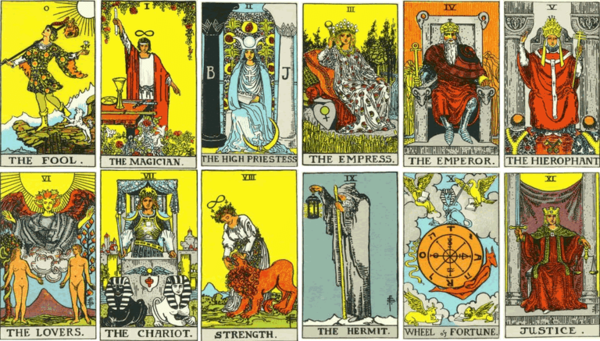Making Time: Why Now is the Perfect Time for Tarot
By Shazia Hafiz Ramji
I don’t want to pretend that I know the history of the Tarot or how it should be used, but I’ve been using it for the last three years because it’s been immensely helpful. I’m not an “expert,” but I am experienced.
My encounter with the Tarot began when I was 11. My aunt had a deck of Tarot cards. In our small Muslim family, it was scandalous for a woman to have a deck of cards featuring many naked people and an ominous horned Devil, and though my mother and aunt said their prayers on time every day, they both took to the Tarot hungrily. Mom read my aunt’s “fate,” and pulled The Lovers card, provoking riotous inside jokes and laughter for years. After they put the deck away, Mom said a quick prayer and asked for forgiveness from God for dallying with shaytan – in the eyes of my mom and aunt, the Tarot intervened with fate and told the future; it was the devil’s work.
My own turn with the Tarot came when I snuck into my aunt’s place to peek at the deck. I remember reading the instruction pamphlet in the box: “ask a question to the Tarot and pull a card.” I asked a question, but I don’t remember what it was. I picked a card, but I don’t remember what it was. What I do remember is the feeling I got after seeing the card and reading the small pamphlet-summary of what it heralded. I remember being terrified, as if I had spoken with myself from the future.
Four years ago, I visited Banyen Books to buy something for my mom. I immediately recognized the figure of The Magician on a bright yellow Rider-Waite deck (like my aunt’s) at the back of the store and promptly bought it.
I bought it for writing. (I’ve talked about how I use the Tarot in writing for one of my first Open Book columns: Reading Tarot for Story.) Using the Tarot for writing developed my trust in it. In the beginning, I was astonished that each card would take the character further into her internal journey towards change, often to a recognition of something hideous within herself. How was it possible that it led my characters to exactly where they needed to be? Of course, a cynical person might dismiss it as projection, but that is one way of looking.
My trust in the Tarot is rock solid because I was able to finish stories with it when I couldn’t before. I noticed patterns of experience in each of my stories: patterns I couldn’t break through without Tarot, likely because most of my writing is autofictional (and sometimes the material is too close to me). Eventually, I began giving myself readings. I would pick a card and navigate to Biddy Tarot for understanding. What I found would often illuminate a thought, a feeling, a wish that I had recognized in myself but had chosen to forget or dismiss, sometimes consciously, but often unconsciously. Tarot became a way of listening to myself. It’s guidance in my life has become profound in these Corona days.
Picking a card in the morning gives direction to my day. (This is not the same as waiting for the card to tell me how to spend the rest of my day – I choose not to read Tarot that way.) This morning I picked the Knight of Cups – the romantic’s card. What resonated for me from the Biddy Tarot reading was the phrase, “true imagination feeds on action.” That is a superb reminder to have in the morning. Do I remember how the rest of my day went? Did I record every event that made the Knight of Cups’ phrase come true? Did I truly take action instead of dreaming? I don’t know. But I know that it made me feel different about the day, it made me feel more defined, as if I could see myself more clearly. I was more aware of my emotions, more attuned to myself.
At night, I pick a card to find out where I am in comparison to the morning. Each pick continues to be accurate, and by “accurate” I mean that it’s relatable. And because I’ve been picking them for so long, I’ve noticed that certain moods will call certain cards, that there is a recurring pattern of experience in my body – like the patterns in my stories – and picking a card is just one way of finding myself again and again in a life-motif, in a larger divinity.
Reading the Tarot now can give shape to our unstructured days. We might have our jobs to do from home or may be waiting on CERB money; but each pull of the card grounds us in time by returning us to our bodies. Pulling one card each morning and another card each night can be a quick way to become familiar with the Tarot, to spiritualize your life, and to create a deeper emotional attunement for yourself through ritual and reflection.
I still haven’t read a “how-to” book on Tarot, but I trust it so much that I have to ask: What are you waiting for?
Your CanLit News
Subscribe to Open Book’s newsletter to get local book events, literary content, writing tips, and more in your inbox
The views expressed by Open Book columnists are those held by the authors and do not necessarily reflect the views of Open Book.
Shazia Hafiz Ramji’s fiction was shortlisted for the Malahat Review’s 2022 Open Season Awards. Her poetry was shortlisted for the 2021 National Magazine Awards and the 2021 Mitchell Prize for Faith and Poetry. Shazia’s award-winning first book is Port of Being. She lives in Vancouver and Calgary, where she is at work on a novel.




